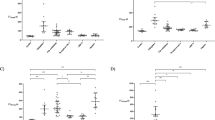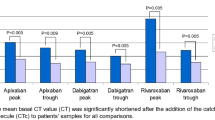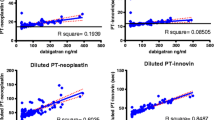Abstract
This study investigated the influence of the oral direct inhibitor of factor Xa rivaroxaban on blood coagulation measured by rotation thrombelastometry ROTEM™. Blood was obtained from 11 healthy male volunteers before and 2.5 h after oral administration of 10 mg rivaroxaban. In addition to standard coagulation tests clot formation was measured by ROTEM™ analyzing extrinsic (Extem) and intrinsic thrombelastometry (Intem). Significant differences to the baseline values were found in the Extem clotting time (Extem-CT, 58 ± 9 s and 87 ± 17 s, p < 0.01), Intem-CT (194 ± 26 s and 239 ± 43 s; p = 0.02), prothrombin time (PT, 86 ± 9% and 67 ± 7%; p < 0.01) and activated partial thromboplastin time (aPTT, 28 ± 1 s and 35 ± 2 s; p < 0.01). There was a low correlation between Extem-CT and PT as well as between Intem-CT and aPTT before and after rivaroxaban intake. The receiver operating characteristic curve (ROC) analysis determined aPTT to be the most appropriate parameter for the prediction of rivaroxaban-induced anticoagulation, Intem-CT and Extem-CT proved to be moderate tests and PT had no significance in the prediction of rivaroxaban-induced anticoagulation. Of utmost clinical importance was the fact that rivaroxaban treated patients could still show normal ROTEM™ values. Thus, ROTEM™ cannot be a suitable test method to exclude inhibition of blood coagulation by rivaroxaban.
Zusammenfassung
Hintergrund
Rivaroxaban ist ein oraler, direkter Faktor-Xa-Inhibitor. Eine Gerinnungsüberwachung ist bei Rivaroxaban nicht mehr nötig. Mithilfe der Rotationsthrombelastometrie ROTEM™, einem häufig benutzten „Point-of-care“-Gerinnungsmessgerät, wurde der Einfluss von Rivaroxaban auf die Blutgerinnung untersucht.
Methode
Elf gesunde, männliche Freiwillige wurden in die Studie aufgenommen. Blutproben wurden vor und 2,5 h nach Einnahme einer 10-mg-Tbl. Rivaroxaban (Xarelto™) entnommen. Zusätzlich zu den gebräuchlichen Gerinnungstests wurden mithilfe des ROTEM™ die extrinsische (Extem-) und die initrinsische (Intem-)Gerinnselbildung gemessen.
Ergebnis
Es zeigten sich statistisch signifikante Unterschiede zu den Ausgangsmessungen für die Extem-Parameter „clotting time“ (Extem-CT, 58 ± 9 s und 87 ± 17 s; p < 0,01), „clot formation time“ (Extem-CFT, 113 ± 30 s und 87 ± 20 s; p < 0,01), Extem-α-Winkel (68 ± 5° und 73 ± 4°; p < 0,01), Intem-CT (194 ± 26 s and 239 ± 43 s; p = 0,02), Prothrombinzeit (PT, 86 ± 9% und 67 ± 7%; p < 0,01) und aktivierte partielle Thromboplastinzeit (aPTT, 28 ± 1 s und 35 ± 2 s; p < 0,01). Es gab eine schwache Korrelation zwischen Extem-CT und PT sowie zwischen Intem-CT und aPTT vor und nach der Einnahme von Rivaroxaban. In der „Receiver-operating-characteristic-curve“(ROC)-Analyse fand sich aPTT als bester Test zur Erfassung einer durch Rivaroxaban beeinflussten Gerinnung. Extem-CT und Intem-CT erwiesen sich als gute bis moderate Parameter und PT als ungeeignet.
Schlussfolgerung
Ein statistisch signifikanter Einfluss auf die ROTEM™-Parameter konnte 2,5 h nach Einnahme einer 10-mg-Rivaroxaban-Tbl. beobachtet werden. Es fand sich eine größere Beeinflussung der Extem-Parameter, verglichen mit den Intem-Parametern. Eine schwache Korrelation zwischen Extem-CT und PT sowie zwischen Intem-CT und aPTT vor und nach Rivaroxabaneinnahme wurden beobachtet. Als bester Parameter zur Erfassung einer durch Rivaroxaban beeinflussten Gerinnung erwies sich aPTT. Extem-CT und Intem-CT sind ebenfalls gute bis moderate Parameter; die PT ist für diese Fragestellung ungeeignet. Von großer klinischer Relevanz ist die Tatsache, dass nach Rivaroxabaneinnahme immer noch normale ROTEM™-Werte gemessen werden können. Das Point-of-care-Gerinnungsmessgerät ROTEM™ ist nicht dafür geeignet, eine durch Rivaroxaban verursachte Gerinnungshemmung vor zentralvenösen Punktionen oder rückenmarknahen Anästhesien auszuschließen.



Similar content being viewed by others
References
Bauersachs R, Berkowitz SD, Brenner B et al (2010) Oral rivaroxaban for symptomatic venous thromboembolism. N Engl J Med 363:2499–2510
c et al (2010) Effects on coagulation of balanced (130/0.42) and non-balanced (130/0.4) hydroxyethyl starch or gelatin compared with balanced Ringer’s solution: an in vitro study using two different viscoelastic coagulation tests ROTEMTM and SONOCLOTTM. Br J Anaesth 105:273–281
Cohen AT, Spiro TE, Buller HR et al (2011) Extended-duration rivaroxaban thromboprophylaxis in acutely ill medical patients: MAGELLAN study protocol. J Thromb Thrombolysis 31:407–416
Engstrom M, Rundgren M, Schott U (2010) An evaluation of monitoring possibilities of argatroban using rotational thromboelastometry and activated partial thromboplastin time. Acta Anaesthesiol Scand 54:86–91
Eriksson BI, Borris LC, Dahl OE et al (2007) Dose-escalation study of rivaroxaban (BAY 59-7939)—an oral, direct Factor Xa inhibitor—for the prevention of venous thromboembolism in patients undergoing total hip replacement. Thromb Res 120:685–693
Eriksson BI, Borris LC, Friedman RJ et al (2008) Rivaroxaban versus enoxaparin for thromboprophylaxis after hip arthroplasty. N Engl J Med 358:2765–2775
Ganter MT, Hofer CK (2008) Coagulation monitoring: current techniques and clinical use of viscoelastic point-of-care coagulation devices. Anesth Analg 106:1366–1375
Gibson CM, Mega JL, Burton p et al (2011) Rationale and design of the anti-Xa therapy to lower cardiovascular events in addition to standard therapy in subjects with acute coronary syndrome-thrombolysis in myocardial infarction 51 (ATLAS-ACS 2 TIMI 51) trial: a randomized, double-blind, placebo-controlled study to evaluate the efficacy and safety of rivaroxaban in subjects with acute coronary syndrome. Am Heart J 161:815–821 e816
Herbstreit F, Winter EM, Peters J, Hartmann M (2010) Monitoring of haemostasis in liver transplantation: comparison of laboratory based and point of care tests. Anaesthesia 65:44–49
Kakkar AK, Brenner B, Dahl OE et al (2008) Extended duration rivaroxaban versus short-term enoxaparin for the prevention of venous thromboembolism after total hip arthroplasty: a double-blind, randomised controlled trial. Lancet 372:31–39
Kubitza D, Becka M, Voith B et al (2005) Safety, pharmacodynamics, and pharmacokinetics of single doses of BAY 59-7939, an oral, direct factor Xa inhibitor. Clin Pharmacol Ther 78:412–421
Kubitza D, Haas S (2006) Novel factor Xa inhibitors for prevention and treatment of thromboembolic diseases. Expert Opin Investig Drugs 15:843–855
Lassen MR, Ageno W, Borris LC et al (2008) Rivaroxaban versus enoxaparin for thromboprophylaxis after total knee arthroplasty. N Engl J Med 358:2776–2786
Laux V, Perzborn E, Heitmeier S et al (2009) Direct inhibitors of coagulation proteins—the end of the heparin and low-molecular-weight heparin era for anticoagulant therapy? Thromb Haemost 102:892–899
Mega JL, Braunwald E, Mohanavelu S et al (2009) Rivaroxaban versus placebo in patients with acute coronary syndromes (ATLAS ACS-TIMI 46): a randomised, double-blind, phase II trial. Lancet 374:29–38
Nilsson CU, Engstrom M (2007) Monitoring fondaparinux with the Sonoclot. Blood Coagul Fibrinolysis 18:619–622
Patel MR, Mahaffey KW, Garg J et al (2011) Rivaroxaban versus warfarin in nonvalvular atrial fibrillation. N Engl J Med 365:883–891
ROCKET-AF-Study-Investigators (2010) Rivaroxaban-once daily, oral, direct factor Xa inhibition compared with vitamin K antagonism for prevention of stroke and Embolism Trial in Atrial Fibrillation: rationale and design of the ROCKET AF study. Am Heart J 159:340–347 e341
Roehrig S, Straub A, Pohlmann J et al (2005) Discovery of the novel antithrombotic agent 5-chloro-N-({(5S)-2-oxo-3- [4-(3-oxomorpholin-4-yl)phenyl]-1,3-oxazolidin-5-yl}methyl)thiophene- 2-carboxamide (BAY 59-7939): an oral, direct factor Xa inhibitor. J Med Chem 48:5900–5908
Rugeri L, Levrat A, David JS et al (2007) Diagnosis of early coagulation abnormalities in trauma patients by rotation thrombelastography. J Thromb Haemost 5:289–295
Samama MM, Gerotziafas GT (2010) Newer anticoagulants in 2009. J Thromb Thrombolysis 29:92–104
Samama MM, Martinoli JL, LeFlem L et al (2010) Assessment of laboratory assays to measure rivaroxaban—an oral, direct factor Xa inhibitor. Thromb Haemost 103:815–825
Turpie AG (2007) Oral, direct factor Xa inhibitors in development for the prevention and treatment of thromboembolic diseases. Arterioscler Thromb Vasc Biol 27:1238–1247
Turpie AG, Lassen MR, Davidson BL et al (2009) Rivaroxaban versus enoxaparin for thromboprophylaxis after total knee arthroplasty (RECORD4): a randomised trial. Lancet 373:1673–1680
Acknowledgements
None.
Financial support and sponsorship
None.
Conflicts of interest
The corresponding author states that there are no conflicts of interest.
Author information
Authors and Affiliations
Corresponding author
Rights and permissions
About this article
Cite this article
Casutt, M., Konrad, C. & Schuepfer, G. Effect of rivaroxaban on blood coagulation using the viscoelastic coagulation test ROTEM™. Anaesthesist 61, 948–953 (2012). https://doi.org/10.1007/s00101-012-2091-4
Received:
Revised:
Accepted:
Published:
Issue Date:
DOI: https://doi.org/10.1007/s00101-012-2091-4




